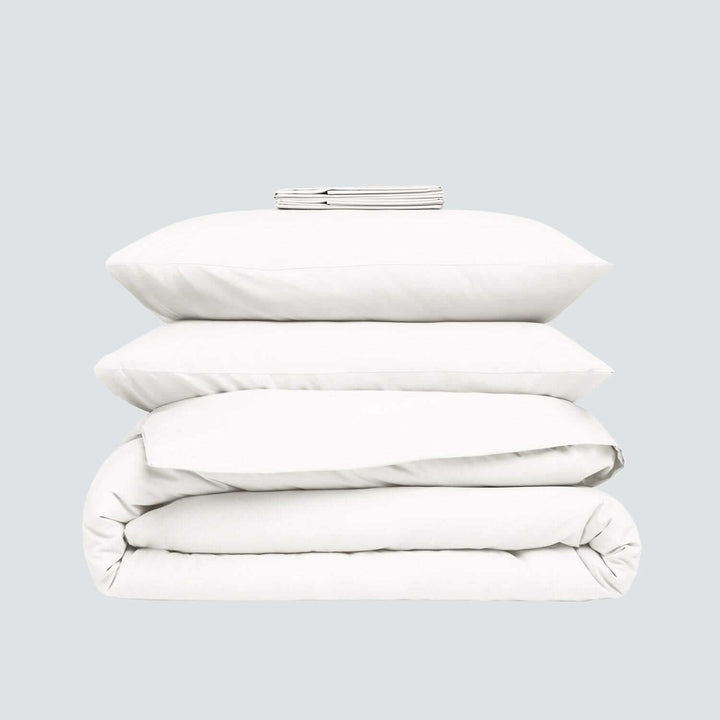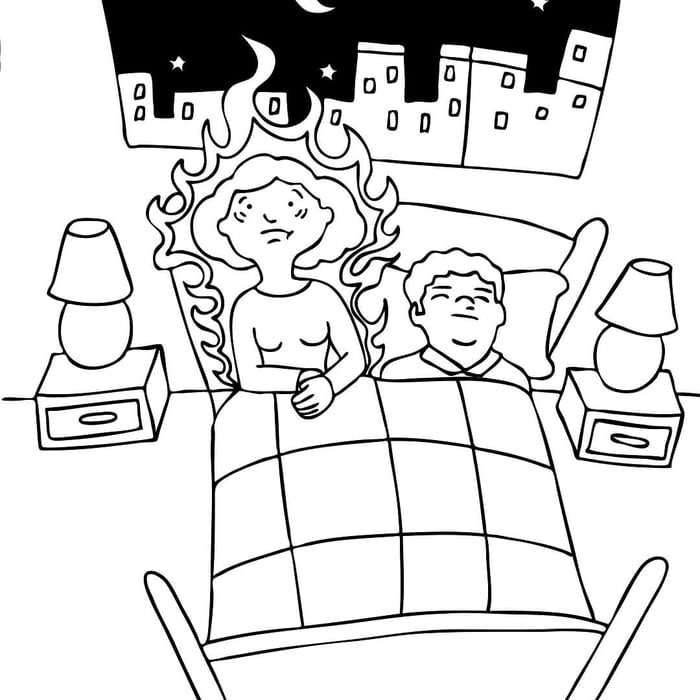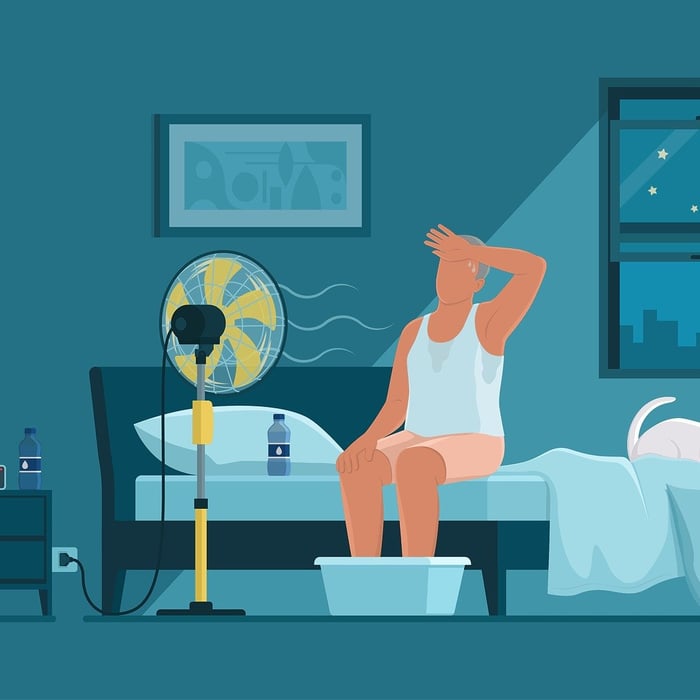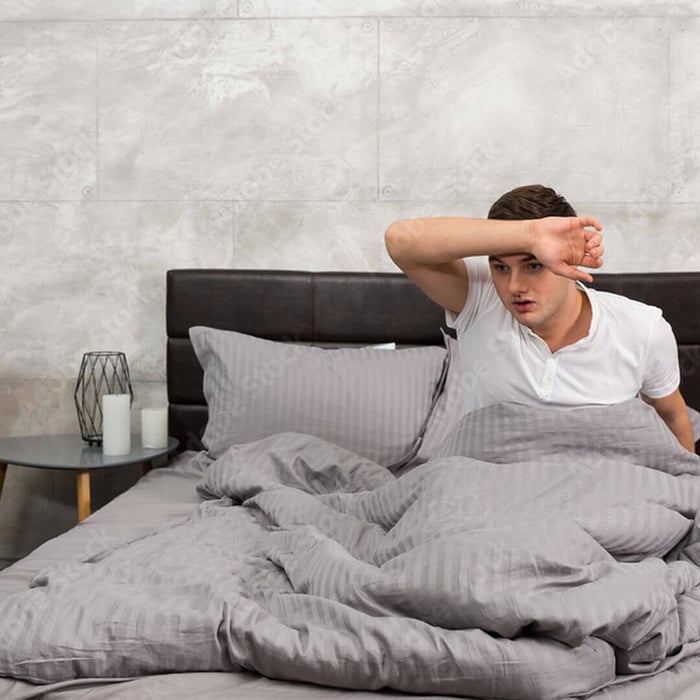Table of Contents
- Night Sweats vs Hot Flashes vs Overheating: How to Tell the Difference
- Quick Summary: What’s the Difference?
- What Are Night Sweats? (Environmental + Body Heat Mix)
- What Are Hot Flashes? (Hormonal Heat Surges)
- What Is General Overheating? (Environment-Driven Heat)
- Side-by-Side Comparison (Simple Table)
- Why Bedding Matters Across All Three
- Why Wool Performs Best
- How to Tell Which One You’re Experiencing
- How to Reduce All Three (Simple Fixes)
- Closing Thoughts: The Differences Between Night Sweats and Hot Flashes and Overheating
- Restore Balance With Naturally Breathable Bedding
- FAQs on Wool Duvet Inserts, Comforters & Sustainable Bedding
Night Sweats vs Hot Flashes vs Overheating: How to Tell the Difference
Waking up with night sweats and hot flashes can mean different things — sometimes it’s night sweats, sometimes it’s hot flashes, and sometimes it’s simply overheating under the wrong bedding.
What's the difference between Night Sweats and Hot Flashes and Overheating? All three feel similar in the moment, but they’re caused by completely different things.
Night sweats and hot flashes feel chaotic, but your bedding shouldn’t. The fastest way to regain control is to Restore Balance With Naturally Breathable Bedding, using fibers that help your body release excess heat instead of trapping it.
And understanding the difference helps you figure out what’s normal, what’s environmental, and what you can fix tonight by adjusting your bedroom climate or your bedding.
This guide isn’t about causes or treatments — it’s about helping you quickly identify which one you’re experiencing so you can take the right next step. Let’s break it down in a simple way that actually makes sense.
Quick Summary: What’s the Difference?
Night sweats → sweating while you sleep, usually because heat or humidity gets trapped
Hot flashes → sudden internal heat surges, most often hormonal
Overheating → your environment or bedding is too warm, too heavy, or not breathable
If you’re experiencing night sweats and hot flashes or overheating regularly, understanding what’s causing them is the first step toward real relief.
Now let’s go deeper.
What Are Night Sweats? (Environmental + Body Heat Mix)
Night sweats happen during sleep, often without you waking up until you feel damp. They usually come from your sleeping environment — heat, humidity, layers, or bedding materials that trap moisture.
Core Signs of Night Sweats
You wake up damp, sticky, or clammy
Sheets feel moist
Hairline or neck is sweaty
Room may feel warm or humid
Common Causes of Night Sweats
Non-breathable bedding
Heavy duvets
Synthetic fabrics
Too many layers
High humidity
Foam mattresses
Being a naturally hot sleeper
Alcohol, spicy meals, or late eating
Night sweats are mostly about temperature mismanagement, not hormones.
Night Sweats and How To Fix
Many people dealing with night sweats and hot flashes assume it’s just hormones—but your sleep environment plays a bigger role than you’d think.
Small changes make a big difference: open a window, reduce layers, and choose bedding that breathes instead of trapping warmth.
Natural fibers like wool and organic cotton help your body stay balanced throughout the night.
Organic Wool Comforter | Made in New Zealand, Breathable All-Season Comfort

$342.00
$380.00
Sleep naturally better with our organic wool comforter Unlike down or synthetic comforters that trap heat, our spun wool design wicks away moisture and prevents overheating, so you stay cool & dry. Designed for deeper sleep with a gentle weight… Read more
Regenerative New Zealand wool helps prevent night sweats because its natural crimp structure lets heat and humidity move away from your skin instead of trapping them beside you.
What Are Hot Flashes? (Hormonal Heat Surges)
Hot flashes feel similar to night sweats, but the cause is internal, not environmental. They’re sudden, intense heat waves driven by hormones — common in:
Perimenopause
Menopause
Postpartum
Pregnancy
Cycle phases
Hormonal shifts
Some medications
Core Signs of Hot Flashes
Sudden heat surge
Face/chest flushing
Pounding heart or rush of energy
Sweat begins quickly
Short-lived, then chills afterward
A hot flash can happen day or night, with or without warm bedding.
Why Hot Flashes Happen
Changing hormone levels affect the hypothalamus (your body’s internal thermostat), causing exaggerated heat responses.
The Fix for Hot Flashes
You can’t stop hormonal changes, but you can make the environment less reactive:
Regulate humidity
Keep the room cool
Use breathable bedding
Avoid synthetics
Reduce caffeine and alcohol at night
Wool helps smooth the temperature swings by absorbing and releasing heat slowly instead of trapping it, which is why it’s so effective for menopause sleep comfort.
Regenerative Organic Cotton Sheet Set – Soft, Breathable & Sustainable

$189.00
Softer Sheets. Cleaner Sleep. Our organic cotton sheet set are simply better for the earth, and for your sleep. Grown on low-impact regenerative farms that actively heal the soil, our cotton is then woven and finished responsibly. This process eliminates… Read more
What Is General Overheating? (Environment-Driven Heat)
When night sweats and hot flashes flare up, the real issue is often humidity.
This is the simplest — and most common — category.
Your room or bedding is too warm. That’s it.
Core Signs of Overheating
You toss off the covers
You wake up warm but not soaked
Sleep feels restless
Body temperature feels high, but no sweat surge
Often seasonal (summer, warm climates)
Main Causes of Overheating
Bedrooms above 20°C / 68°F
Poor airflow
Too many layers
Heavy cotton or down duvets
Foam mattresses
Polyester or microfiber sheets
Closed windows
The Fix for Overheating in Bed
Drop room temperature
Reduce bedding layers
Pick moisture-managing fibers
Improve ventilation
Switch to all-season wool comforter
Overheating is 90% environmental — and easily fixed.
Side-by-Side Comparison (Simple Table)
| Symptom | Night Sweats | Hot Flashes | Overheating |
|---|---|---|---|
| Happens while asleep | Yes | Often | Yes |
| Sudden heat surge | No | Yes | No |
| Trigger | Environment | Hormones | Room/bedding |
| Lasts | Gradual | Short & intense | Gradual |
| Sweat level | Mild–moderate | Moderate–heavy | Mild |
| Affect women more | No | Yes | No |
| Fix | Bedding/environment | Lifestyle + environment | Cooling room + breathable bedding |
Why Bedding Matters Across All Three
Night sweats and hot flashes aren’t just uncomfortable—they’re a signal that your bedding isn’t managing temperature or moisture well.
Whether you’re dealing with night sweats, hot flashes, or general overheating, one factor matters every time:
👉 Can your bedding move heat and moisture away from your body?
Most bedding can’t.
Synthetics trap humidity.
Down traps heat.
Heavy cotton absorbs moisture but dries slowly.
Natural fibers solve this more intelligently — especially wool.
Why Wool Performs Best
Moves humidity before it becomes sweat
Regulates temperature in both directions
Breathes far better than cotton or bamboo
Balances body heat during hormonal changes
Keeps sleep stable through the whole cycle
Supports the body’s natural sleep temperature rhythm
And your regenerative New Zealand wool takes it further:
Our spun wool Airlay design spins wool into tiny airy clusters so heat and humidity can escape — helping you stay dry, balanced, and comfortable through every temperature swing.
Sustainable & Regenerative Bedding Bundle | No More Night Sweats, Just Deeper Sleep

$598.40
$748.00
Cooler Nights & Deeper Sleep — Every Night Elevate your sleep with the only sustainable bundle crafted from regenerative New Zealand wool and organic cotton for true all-season comfort. These breathable, eco-friendly fibers naturally wick away heat and moisture to… Read more
How to Tell Which One You’re Experiencing
It’s probably night sweats if…
Your room feels warm
Sheets or pillow feel damp
You’re a “hot sleeper”
Bedding is synthetic or heavy
You eat late or drink alcohol
It’s probably hot flashes if…
Heat comes on suddenly
Your chest or face flushes
Your heart races for a moment
You’re in perimenopause, postpartum, or pregnancy
Cooling down happens quickly
It’s probably overheating if…
No dampness — just warmth
You toss blankets off
Your bedroom is warm or stuffy
Your comforter is too thick
How to Reduce All Three (Simple Fixes)
Your body sleeps better when the environment around it supports natural temperature balance. These simple adjustments help reduce heat, humidity, and nighttime discomfort across all three issues.
Lower room temperature (but don’t rely on AC alone)
Increase airflow
Use breathable natural bedding
Avoid microfiber, bamboo blends, and synthetics
Sleep in lightweight natural-fiber clothing
Go for a wool comforter with moisture management
Cut back on alcohol before bed
Closing Thoughts: The Differences Between Night Sweats and Hot Flashes and Overheating
Feeling too warm at night doesn’t always mean something is wrong — but it does mean something is out of balance. Whether the heat comes from hormones, your bedroom climate, or your bedding, understanding the difference is the first step to finally sleeping comfortably again.
When you surround yourself with materials that actually breathe, your body doesn’t have to fight so hard to regulate temperature.
Restore Balance With Naturally Breathable Bedding
A cooler, more breathable setup can transform how you experience night sweats and hot flashes—naturally.
If you’re ready to build a sleep environment that works with your body instead of overheating it, explore bedding made from regenerative New Zealand wool and organic cotton.
At Antipodean Home, we help you sleep with nature, not against it — using materials that regulate, breathe, and restore the way nature intended.
Explore Our Hot Sleepers Bedding Collection
FAQs on Wool Duvet Inserts, Comforters & Sustainable Bedding
What’s the difference between night sweats and hot flashes?
Night sweats happen during sleep when trapped heat or humidity builds up around your body. Hot flashes are sudden heat surges that can happen anytime—day or night—often tied to hormonal shifts. Many people experience both, which is why “night sweats and hot flashes” often show up together in search.
Are night sweats and hot flashes always hormonal?
Not always. Hormones can cause heat spikes, but bedding, room humidity, heavy duvets, and synthetics also trigger night sweats and hot flashes by trapping warmth close to the skin.
Can the wrong bedding make night sweats and hot flashes worse?
Yes. Microfiber, bamboo blends, and polyester trap heat and moisture. This amplifies night sweats and hot flashes because sweat can’t evaporate naturally.
What bedding materials help reduce night sweats and hot flashes?
Breathable natural fibers—especially regenerative wool and organic cotton—help maintain airflow, regulate temperature, and move moisture away from your skin, reducing overheating episodes.
Can room temperature alone fix night sweats and hot flashes?
AC helps, but it doesn’t solve the real problem: heat trapped inside your bedding. Even at a cool room temp, synthetics can cause night sweats and hot flashes.
Are bamboo or “cooling” sheets good for night sweats and hot flashes?
Not usually. Many bamboo fabrics are processed into rayon, which traps humidity and clings when damp. Natural fibers outperform blends for people managing night sweats and hot flashes.
How do hormones affect night sweats and hot flashes?
Fluctuations in estrogen, progesterone, thyroid levels, and cortisol can trigger sudden heat surges. During perimenopause or menopause, these surges are more frequent—especially at night.
Can diet or lifestyle trigger night sweats and hot flashes?
Yes. Alcohol, spicy foods, late eating, stress, poor sleep hygiene, and certain medications can elevate temperature and contribute to night sweats and hot flashes.
Are natural fibers really better for night sweats and hot flashes?
Absolutely. Wool naturally manages humidity and heat through its crimp structure, preventing the clammy, damp feeling that often comes with night sweats and hot flashes.
What’s the simplest change I can make tonight?
Switch to breathable bedding—start with a lightweight wool comforter or organic cotton sheets. These small adjustments quickly reduce the severity of night sweats and hot flashes without changing your whole routine.




